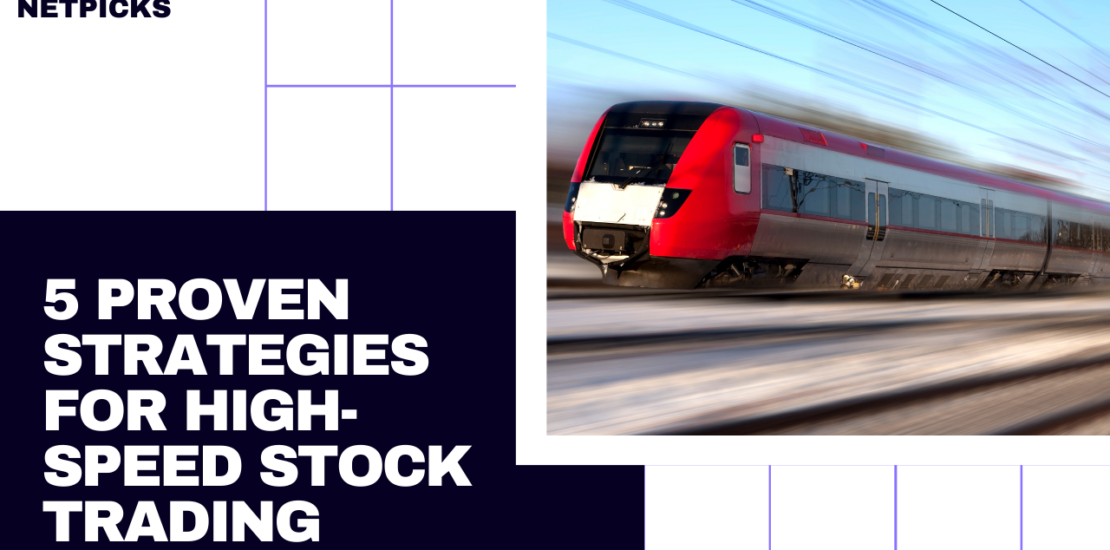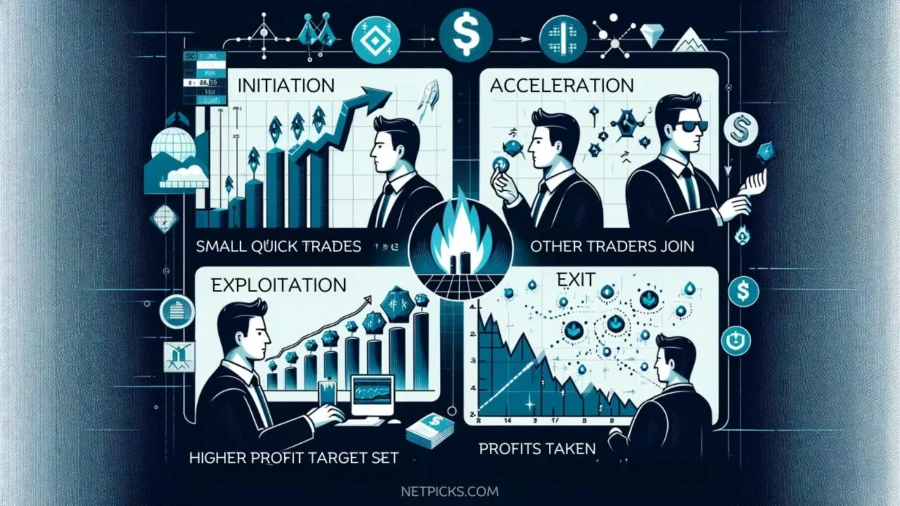- January 29, 2024
- Posted by: Shane Daly
- Categories: Stock Trading, Trading Article

In high-speed stock trading, algorithmic trading and high-speed execution are essential, because you are using algorithms to monitor market data and execute orders. Market making and liquidity are important, as they continuously quote buy and sell prices to capitalize on bid-ask spreads, enhancing liquidity and trading efficiency.
 Statistical arbitrage focuses on profit generation from price discrepancies stemming from market inefficiencies, making use of historical and real-time price information while executing trades at high speed.
Statistical arbitrage focuses on profit generation from price discrepancies stemming from market inefficiencies, making use of historical and real-time price information while executing trades at high speed.
Momentum ignition strategies aim to create buying or selling pressure by initiating a sequence of trades, relying on accuracy and well-timed execution to maximize impact and generate rapid price movements.
TLDR: The best strategies for high-speed stock trading are algorithmic trading, market making, statistical arbitrage, momentum ignition, and latency arbitrage. These approaches use advanced algorithms, data analysis, and rapid execution to profit from price discrepancies, provide liquidity, create buying or selling pressure, and exploit latency-related opportunities in the market
Understanding Algorithmic Trading
Algorithmic trading uses complex algorithms to execute trades at speeds and volumes that no human trader can match. Citadel Securities, as an example, executes trades in milliseconds or microseconds through high-frequency, automated, and algorithmic trading.
You’re dealing with a system that can analyze market data, execute orders based on predefined criteria, and adjust strategies in milliseconds. This speed is needed in exploiting small price discrepancies that vanish quickly — opportunities that you’d miss without algorithmic assistance.
Speed of High-Frequency Trading: High-frequency trading (HFT) can be as fast as 10 milliseconds, allowing large numbers of orders to be executed within seconds.
Your trading strategy’s success depends on backtested and optimized algorithms that can predict and respond to market patterns. The algorithms are fed historical and real-time data, ensuring they make decisions based on comprehensive market analysis. You’ll find that high-frequency trading firms often operate with a latency of mere microseconds, a testament to the efficiency of algorithmic systems.
The Art of Market Making
Market-making strategies provide liquidity and facilitate trade efficiency by continuously quoting buy and sell prices. As a market maker, you’re the intermediary that allows trading to flow smoothly. You benefit from the bid-ask spread, which compensates you for the risk of holding instruments and facilitating trades.
Your success hinges on the ability to anticipate short-term market movements. Using historical data and real-time analytics, you adjust quotes milliseconds before others see shifts in the market.
The data you rely on must be robust and real-time. Latency (delay) in data will destroy your edge; even a few milliseconds of delay can turn a profitable opportunity into a loss. You’re not reacting to market conditions; you’re shaping them. Your quotes can influence the market price, and with your high-speed strategies, you’re guiding the flow of trades.
Profiting From Statistical Arbitrage
Profiting from statistical arbitrage depends on exploiting price discrepancies that arise from market inefficiencies, often requiring complex mathematical models and high-frequency trading algorithms to identify and act upon these opportunities. You’re not betting on a stock’s upward movement; you’re capturing the spread that comes from temporary imbalances between a pair of stocks or a portfolio of assets.
The success in statistical arbitrage is data-driven. You must analyze historical price relationships and construct a model that predicts convergence or divergence of pricing. When the model signals an opportunity, you execute trades at high speed to capitalize before the market self-corrects.
| Component | Description | Impact on Strategy |
|---|---|---|
| Data Quality | Accuracy of historical and real-time price information | Critical for model precision |
| Computational Speed | Rate of executing trades based on the model’s signals | Determines the ability to capitalize on opportunities |
| Model Complexity | Degree of sophistication in identifying price discrepancies | Enhances profitability potential |
| Market Volatility | Frequency and magnitude of price discrepancies | Influences the number of viable trading opportunities |
You must manage risks by ensuring your models are robust and can be adapted to different conditions. Keep in mind that transaction costs can eat at your profits, so efficiency and precision are paramount.
Momentum Ignition Explained
 Momentum ignition is a strategy where traders intentionally initiate a series of trades to create the appearance of rapid buying or selling pressure, aiming to trigger a price movement that they can then exploit. It is often executed by algorithmic traders who can move quickly and in volume.
Momentum ignition is a strategy where traders intentionally initiate a series of trades to create the appearance of rapid buying or selling pressure, aiming to trigger a price movement that they can then exploit. It is often executed by algorithmic traders who can move quickly and in volume.
Here’s how it breaks down:
- Initiation: The trader executes small but quick trades to nudge the stock’s price in the desired direction.
- Acceleration: As other traders and algorithms detect this movement, they jump in, adding fuel to the price change.
- Exploitation: The initiating trader anticipates the snowball effect and sets a higher (or lower) target to sell (or buy) the stock in bulk.
- Exit: Once the target price is hit, the trader exits the position, often leading to a rapid price reversal.
This play relies on data analysis to identify susceptible stocks and “down to the penny” execution to minimize risk.
Latency Arbitrage Opportunities
Almost every high-speed trader seeks to capitalize on latency arbitrage opportunities, which arise when price discrepancies occur due to the delay in the the spread of stock prices across different exchanges.
To exploit these opportunities, you’ll need sophisticated algorithms capable of detecting and acting on price variances instantaneously. Your systems must be fine-tuned to analyze the flood of market data, identifying when the same asset is trading at divergent prices on two platforms.
Once detected, an automated trade is executed, buying low on one exchange and selling high on another, pocketing the difference before the markets can self-correct.
Here is an example to help you understand:
 Imagine there are two websites, Website A and Website B, selling tickets for a very popular concert. Both websites update their ticket prices at different times based on the demand and remaining tickets. Website A updates its prices every 30 seconds, while Website B does so every minute.
Imagine there are two websites, Website A and Website B, selling tickets for a very popular concert. Both websites update their ticket prices at different times based on the demand and remaining tickets. Website A updates its prices every 30 seconds, while Website B does so every minute.
You have a fast internet connection and a program that can check both websites’ prices instantly. At a certain moment, you notice that Website A has dropped the price of a ticket due to a sudden increase in availability. You quickly buy a ticket at this lower price.
Within the next 30 seconds (before Website B updates its price), you notice that Website B is still selling the ticket at a higher price. You quickly list and sell the ticket you just bought on Website B at this higher price, making a profit from the price difference.
In this scenario, the “latency” is the time lag between when Website A and Website B update their prices. By taking advantage of this lag, you’re engaging in a form of latency arbitrage – you’re exploiting the brief window where the same ticket has two different prices on two different websites.
Understand that latency arbitrage is highly competitive. You’re up against firms that invest heavily in state-of-the-art infrastructure, including colocated servers and high-speed data feeds, to minimize response times. Your success hinges on how swiftly and efficiently your system can process data and execute trades.
Regulatory scrutiny is intensifying around these practices, as they can contribute to market instability.
Conclusion
By using algorithmic strategies, you’re positioned to exploit market inefficiencies. Market making lets you profit from bid-ask spreads, while statistical arbitrage can deliver gains from price discrepancies. Momentum ignition propels you to capitalize on trend inducement, and latency arbitrage offers an edge by reacting faster than the competition.

